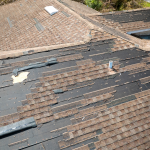
What Does Wind Damage Look Like on a Roof?
February 26, 2024
Roof Washing Services: All You Need To Know
August 21, 2024Key Takeaways:
- Coverage Depends on Cause and Policy Specifics: Homeowners insurance generally covers roof damage caused by sudden and unexpected events, such as storms, hail, or fire, but not damage due to wear and tear, negligence, or gradual deterioration.
- Supplemental Options and Maintenance: If your standard policy has limitations, supplemental roof insurance or policy riders can help cover replacement costs.
- Age and Condition of the Roof Impact Coverage: Older roofs or those in poor condition may not be covered as extensively, and some insurers impose limits or higher deductibles.
Are you wondering if homeowners insurance covers a new roof? It’s a common question for many homeowners, especially if you’re facing roof damage or thinking about a replacement. Insurance policies can vary, so it’s important to understand what might be covered under your plan.
We’ll break down the basics of how homeowners insurance typically handles roof replacements, and what you need to know to make sure you’re covered. Whether you’re dealing with storm damage or simply planning an upgrade, knowing the details of your insurance coverage can make a big difference.
Understanding Homeowners Insurance Basics
Understanding homeowners insurance is key to protecting your property and belongings from unexpected events. Most policies cover damage from things like fire, theft, vandalism, and certain natural disasters, but more on this later.
To find out exactly what’s covered, how much the deductibles are, and the extent of that coverage, it’s important to study your policy. Remember that although most policies cover a broad range of hazards, there are often exclusions and restrictions. Homeowner insurance policies are crucial to help you put your home back in order should a disaster strike.
What Exactly Can Be Covered by Homeowners Insurance
Homeowners insurance is like a safety net for your home and belongings. But what exactly does it cover? Typically, it protects you against a variety of risks that could cause damage to your property. For example, if a fire breaks out, your policy will usually help pay for repairs or even rebuilding. If someone breaks in and steals your stuff, insurance can cover the cost of replacing those items.
Vandalism is another issue that’s often covered, so if someone decides to cause some damage to your home, you won’t have to handle the repair costs alone. Natural disasters, like certain storms, may also be included, but it’s good to check the specifics, as not all disasters are covered automatically.
What is Not Covered by Homeowners Insurance
Homeowners insurance covers a lot, but it’s not a catch-all. There are some things it won’t pay for, and it’s good to know what those are upfront.
For starters, damage caused by floods isn’t typically covered unless you have a flood-specific policy. If you live in an area prone to flooding, you’ll likely need separate flood insurance. Earthquakes are another example—many standard policies don’t cover them, so you’d need additional coverage if you’re in a quake-prone area.
Normal wear and tear or maintenance issues, like a roof that’s just old and needs replacing, aren’t covered either. Homeowners insurance is designed for sudden, unexpected events, not for things that happen gradually over time.
Lastly, certain kinds of mold, animal/pest infestations, or damage from neglect might not be covered. The key takeaway is that while homeowners insurance is a solid safety net for many things, it has its limits. Understanding policy limits can save you from surprises down the road.
Does Homeowners Insurance Cover a New Roof?
When it comes to homeowners insurance and a new roof, it depends on the situation. If your roof gets damaged by something like a storm, hail, or fire, your insurance might help cover the cost of repairs or even a full replacement.
If your roof is just getting old and needs to be replaced due to wear and tear, that’s typically not something insurance will cover. The key is that the damage has to be caused by something sudden and unexpected.
Factors That Determine Coverage For a New Roof
Whether homeowners insurance covers a new roof depends on several factors. First, the cause of the damage plays a significant role. Most policies cover damage from sudden and accidental events like storms or fires, but they typically do not cover damage due to general wear and tear or lack of maintenance.
The specifics of your policy matter! Coverage can vary widely, so it’s essential to review your policy to see whether it covers full replacement of the roof, repairs, a specific portion of the costs and under which circumstances each would apply. Some policies may offer more comprehensive coverage than others.
The age of your roof is another important factor. Many insurance policies have limits on coverage for older roofs, so if your roof is past a certain age, it might not be covered as fully as a newer one.
What Are Alternative Options for Roof Coverage
When it comes to covering your roof, there are several options beyond standard homeowners insurance. Exploring these alternatives can offer additional protection and financial flexibility for your home. Let’s see what exactly are the options:
Supplemental Roof Insurance
As some insurance companies move away from covering roof storm damage to the extent they have historically, there may be different tiers of roof coverage you want to consider. In the past, most homeowner policies have covered roof replacement due to hail or wind in the same way they would cover any other loss. But as property repair costs exploded during and after 2020 and insurance carriers were forced to pay higher repair costs than originally expected, these carriers looked for ways of mitigating their claim liability. One of the ways some insurance providers are doing that is by treating some forms of roof damage differently.
Some carriers are now adding higher deductibles for roof-specific damage, adding policy riders for roof damage, covering up to the depreciated value (actual cash value) of the roof rather than replacement value, or outright denying coverage if the roof is in poor condition or past a certain age. Supplemental roof insurance or policy riders are a way to achieve replacement coverage if not included in the primary homeowner’s policy.
Financing And Payment Plans
Whether paid for by insurance or out of pocket, distributing costs over time by means of financing or other credit-based payment options may add flexibility to how homeowners manage their immediate expenses. These choices give homeowners the ability to increase property value, improve roof function, manage monthly finances more evenly, and possibly even get a lower insurance premium.
Preventing the Need for a New Roof
Keeping up with regular roof maintenance and repairs can help you avoid needing a new roof too soon. Insurance companies often offer discounts for upgrades that make your roof last longer and handle bad weather better. By staying on top of repairs, keeping your roof clean or even using impact-resistant materials, you not only get the most out of your existing roof, but also secure your home’s safety and value. Plus, these proactive steps can lead to fewer issues with insurance claims.
Maintenance And Repair Tips
Keeping up with regular roof maintenance is essential to help the roof stay strong and last longer. Checkups, fixing small problems right away, and keeping things dry are key to avoiding big repair bills and keeping your home’s value intact.
Look out for things like missing shingles, exposed or popped nails, and be sure to check the flashings around chimneys and round other penetrations. Keep your gutters clear of leaves and debris, and trim any branches hanging over the roof.
Insurance Discounts for Roof Upgrades
Insurance companies love new and upgraded roofs! Many have widely varying rates depending on the age of your roof. They may even outright require your roof to be replaced prior to writing a new policy or renewing the policy you have. By choosing better materials, improving warranties, and boosting safety features, you can lower your insurance premiums and increase your home’s value. Not only will your roof look great and last longer, but extended warranties also give you peace of mind. So invest in a top-notch roof—it could save you money and will keep your home in fantastic shape!
With these simple steps, you can keep your roof functioning properly and avoid costly surprises.
Frequently Asked Questions
Does Homeowners Insurance Cover a New Roof?
It depends on the cause of the damage and the insurance policy specifics. If the roof was damaged at a specific moment in time by a covered peril, such as a storm or fire, then your homeowner’s insurance likely provides coverage.
What Qualifies As a Covered Peril For Homeowners Insurance?
Covered perils vary depending on your specific insurance policy, but common examples include fire, hail, wind, and vandalism. It’s important to review your policy to understand what is covered as specific items covered and to what extent, is changing all the time.
Will My Homeowners Insurance Cover a New Roof If The Damage Was Caused By Wear And Tear?
No, wear and tear is typically not covered by homeowners insurance. This type of damage is considered to be the responsibility of the homeowner to maintain and repair their property.
Is There a Limit To How Much Coverage My Homeowners Insurance Will Provide For a New Roof?
Yes, there is usually a limit to the amount of coverage for a new roof. This limit is based on the value of your home and can vary depending on your insurance policy. It’s important to review your policy to understand your coverage limits.
Can I File a Claim For a New Roof If It Was Damaged Due To My Negligence?
No, homeowners insurance typically does not cover damage that is caused by homeowner negligence. This includes failing to properly maintain the roof or neglecting repairs that could have prevented the damage.
What Steps Should I Take If I Need To File a Claim For a New Roof?
If you believe your roof has been damaged and you believe the peril is covered by your homeowner’s insurance, contact a roofing contractor to confirm the damage. You don’t want to file an insurance claim only to find that the damage is the result of a maintenance item. If there is clear and noticeable damage to your roof (ex, a tree falling through your roof), you should contact your insurance provider as soon as possible. They can guide you through the claims process and provide information on what documentation and evidence you may need to provide.





